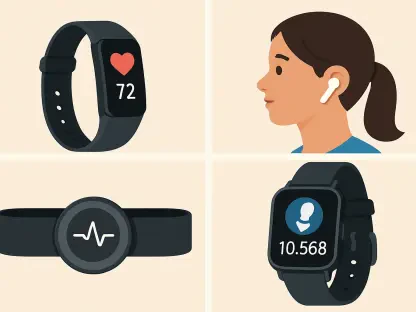The rapid evolution of payment technologies has positioned Southeast Asia at the forefront of transformative financial landscapes, driven by innovative digital solutions. Among these, QR payment systems have emerged as a vital catalyst, reshaping economic interactions across the region. Leveraging mobile-first strategies, Southeast Asian countries are bypassing traditional card-based networks to embrace QR-based solutions that offer unmatched convenience and interoperability. This shift not only propels these countries into the modern digital economy but also provides a roadmap for other nations grappling with infrastructure challenges.
QR Payments: A Mobile-First Revolution
Seamless Transactions Across Diverse Sectors
In Southeast Asia, QR code payment systems have become a staple across various sectors, from bustling street markets to sophisticated retail environments. The cities of Jakarta and Bangkok exemplify this transition, demonstrating how QR technology seamlessly integrates into everyday commerce. In these urban centers, payment using QR codes extends well beyond convenience, functioning as an economic accelerator that encourages financial inclusivity. Whether at a local supermarket or a street vendor selling traditional dishes like nasi goreng, the process is quick and efficient; a simple scan initiates a transaction instantly.
These advancements are underpinned by strong government support, which facilitates the transition to a cashless society. By reducing transaction fees and collaborating with financial institutions, governments create an environment conducive to rapid technological adoption. This not only fuels domestic cashless transactions but also promotes global financial exchanges, cementing the region’s position as a digital payments leader. The lack of need for costly infrastructure, such as Electronic Data Capture devices, allows quicker adoption and minimizes the barriers typically associated with modern financial innovations.
Interoperability and Cross-Border Innovation
Thailand’s capital, Bangkok, further illustrates the adaptability and ingenuity of QR codes, especially their role in fostering cross-border financial integration. As a city teeming with international activity, the need for fluid payment methodologies that support diverse currencies is essential. QR payments meet this need with impeccable ease, thanks to ASEAN’s strategic initiatives in enhancing interconnectivity across its member states’ banking systems. Real-time, cross-border transactions enable seamless economic interactions, such as when a street vendor efficiently receives payment in local currency through a foreign banking application with automatic currency conversion.
This innovative financial framework not only simplifies transactions but also strengthens regional ties and cooperation among the ASEAN countries. By deeming QR payments as a primary mechanism for cross-border commerce, these nations demonstrate their commitment to leveraging cutting-edge technology to foster inclusive growth and economic unity. Consequently, the model employed in Thailand serves as a testament to the effectiveness of centralized financial collaborations in boosting both local and international economies.
The United States: A Contrast in Adoption
Inconsistencies in Mobile Payment Usage
While Southeast Asia embraces the potential of QR systems, the United States provides a stark yet compelling contrast in the landscape of mobile payment adoption. Known as a pioneer in digital services, America has demonstrated slower adaptation compared to the unified approach observed in Southeast Asia. Major cities like Washington, D.C., exhibit a blend of technological sophistication alongside persistent traditional practices. For example, metropolitan transit systems in Washington integrate mobile technologies efficiently, yet a pervasive inconsistency is evident elsewhere.
Despite widespread retail acceptance of tap-to-pay systems, significant gaps remain, particularly in smaller establishments that continue to prefer cash-only transactions. The presence of outdated magnetic stripe card systems, notably in key transport hubs like airports, reflects a broader reluctance to adopt more modern payment technologies. These examples underscore the differences within the U.S. market, suggesting a resistance to fully embrace the available technological advancements.
Silicon Valley: The Promise Versus Reality
Silicon Valley, long heralded as a cradle of tech innovation, adds another layer to the narrative of America’s mobile payment milieu. While startups and tech giants here invest heavily in advancing digital payment solutions, the penetration and mainstream acceptance vary significantly across different regions and sectors. Although Apple Pay and similar technologies offer streamlined payment options, the transition from traditional credit and debit cards remains a gradual process.
The disparity in adoption rates raises questions about the future trajectory of mobile payments in the U.S. Will the country’s financial institutions and businesses champion a unified system akin to Southeast Asia’s QR code model, or will the fragmented landscape continue to evolve at its own pace? Understanding these dynamics is crucial, as it implicates broader global economic interactions and underlines the urgency of addressing technological inertia.
A Global Perspective on QR Codes and Financial Ecosystems
Technology as an Economic Equalizer
Southeast Asia’s strategic deployment of QR payment systems highlights the potential of technology as a significant equalizing force in the financial world. Countries worldwide can draw valuable lessons from this region’s agile approach to adoption. For nations with sparse traditional banking infrastructure, the concept of harnessing ubiquitous smartphone technology to build accessible and affordable payment solutions is profoundly transformative. By focusing on enhancing digital literacy and ensuring greater internet penetration, particularly in remote and underserved areas, countries can encourage the natural progression toward a cashless economic framework.
Moreover, QR payments demonstrate that countries need not rely on developing a heavy card-based infrastructure to achieve technological parity. Instead, the cost-effectiveness and simplicity inherent in QR systems bring opportunities for economic empowerment to societies with diverse technological capabilities and resources. Southeast Asia’s success stories serve as a global blueprint for how nations across all stages of development can effectively leverage such technology to bridge economic divides and foster inclusive growth.
Charting Future Trends and Opportunities
The swift advancement of payment technologies has placed Southeast Asia at the leading edge of transformative financial developments, propelled by cutting-edge digital solutions. QR payment systems have become significant drivers of change, revolutionizing the way economic interactions take place across this vibrant region. By adopting mobile-first strategies, Southeast Asian nations are sidestepping traditional card-based networks in favor of QR-based solutions that offer unparalleled convenience and interoperability. This transformation not only extends these countries’ reach into the modern digital economy but also provides a model for other nations facing infrastructure hurdles. As mobile technology becomes increasingly integral to daily life, QR payments exemplify how Southeast Asia is navigating these changes. Not only are these systems fostering financial inclusion, but they are also simplifying commerce for millions, enhancing both speed and security. This evolution is not merely a regional success; it offers valuable insights for global economies trying to overcome similar challenges.









